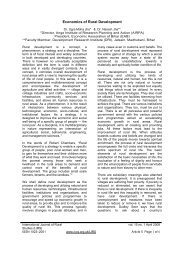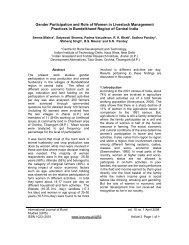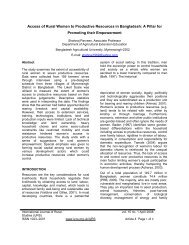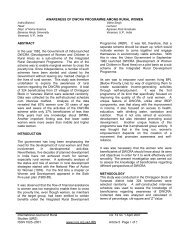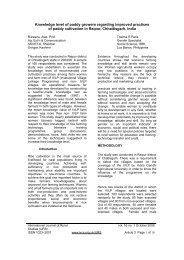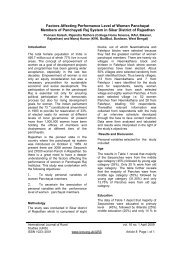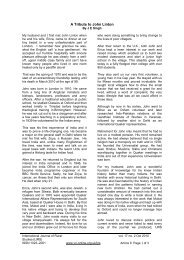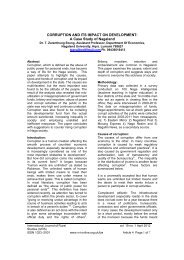8. Self Help through Microfinance: A paradigm shift in Orissa, India
8. Self Help through Microfinance: A paradigm shift in Orissa, India
8. Self Help through Microfinance: A paradigm shift in Orissa, India
Create successful ePaper yourself
Turn your PDF publications into a flip-book with our unique Google optimized e-Paper software.
1. Maa Durasuni <strong>Self</strong> <strong>Help</strong> Group(Female)2. Adam Changa <strong>Self</strong> <strong>Help</strong> Group(Male)3. Patherkata Village Committee4. Kalajh<strong>in</strong>i Mahila <strong>Self</strong> <strong>Help</strong> Group(Female)5. Maa Bhagabati Sangh (Female)6. Purana Sahi Mahila <strong>Self</strong> <strong>Help</strong>Group (Female)7. Jay Hanuman Krushak KalyanSangh (Male)<strong>8.</strong> Maa Tar<strong>in</strong>i Mahila Samiti (Female)The biggest revolution <strong>in</strong> microf<strong>in</strong>ancestarted <strong>in</strong> the late 90s and early 2000 withboth national (<strong>India</strong>n) and <strong>in</strong>ternationalagencies <strong>in</strong>volved <strong>in</strong> br<strong>in</strong>g<strong>in</strong>g socialupliftment <strong>through</strong> microf<strong>in</strong>ance.International donors channelisedmicrof<strong>in</strong>ance <strong>through</strong> local NGOs with aproven track of work<strong>in</strong>g at grass root levelwhereas the Government of <strong>India</strong>channelised rural f<strong>in</strong>ancial services<strong>through</strong> nationalized banks and NGOs.The SHGs under this study were benefitedby rural f<strong>in</strong>ancial services from bothnational and <strong>in</strong>ternational donors.3 The group members were f<strong>in</strong>ed Rs. 1 fornot attend<strong>in</strong>g monthly meet<strong>in</strong>gs. In case ofdefault <strong>in</strong> repay<strong>in</strong>g the loan, memberswere f<strong>in</strong>ed Rs. 1 for Rs. 10.Governance & PolicyAfter <strong>in</strong>itiation of these SHGs, themembers decided to conduct one groupmeet<strong>in</strong>g every month and made itmandatory that all members had to attend.In every group meet<strong>in</strong>g, proceed<strong>in</strong>gs wererecorded by the secretary or president.Those absent from the meet<strong>in</strong>g were f<strong>in</strong>ed(Rs. 1 to 3 based on the group) permeet<strong>in</strong>g (except for emergencies). Bycommon consent, the groups fixed themonthly members’ sav<strong>in</strong>g (Rs. 10 to 20)and the <strong>in</strong>terest on the loan was fixed at 4-5% per month.Formation of Association<strong>Orissa</strong> is one of the most backward states<strong>in</strong> <strong>India</strong>. The backwardness is due to itstraditional forms and frames <strong>in</strong>fluenced bythe social environment and problems.Livelihoods are based on traditionalagriculture and wage labour. There isabsolutely no provision of credit except forvillage moneylenders, neighbors andrelatives. Rural f<strong>in</strong>ancial services havealways been very poor. Livelihoods havebeen fully under the control of nature.Under the active <strong>in</strong>fluence and motivationof NGOs, villagers have formedassociations (both male and female) forself-help or thrift and credit groups. Mostgroup members are married villagers, whohave a common perception of need andimpulse towards collective action. Theywere encouraged to form mutual help<strong>in</strong>gassociations.The villagers were unable to perceive thereason beh<strong>in</strong>d their absolute and relativepoverty. They were unable to understandthe complexities beh<strong>in</strong>d rural <strong>in</strong>debtednessand poverty. The vicious circle of povertyseemed unbreakable. At that po<strong>in</strong>t, withthe <strong>in</strong>tervention of NGOs and govt.agencies, some of the women understoodthe problem and possible solutions tomitigate it. Thus some women folk cameforward and developed SHGs.Bank L<strong>in</strong>kageWith<strong>in</strong> six months of formation, all thegroups opened accounts <strong>in</strong> commercialnationalized banks with the help of NGOswho had earlier assisted their <strong>in</strong>itiation. Allthe SHGs opened their accounts as earlyas possible. There were regulartransactions between the bank and thegroup. The group deposited their sav<strong>in</strong>gsevery month and withdrew them whenrequired. All groups were f<strong>in</strong>anced by thebank with seed money loans and with<strong>in</strong> sixmonths all groups had repaid the loan.The Status of SHGs by 31 Dec 2004Status of the female groups on micro-f<strong>in</strong>ancial transactionCash <strong>in</strong> INR RupeesInternational Journal of Ruralvol. 15 no. 1 AprilStudies (IJRS)2008ISSN 1023–2001 www.ivcs.org.uk/IJRS Article 8 Page 3 of 7



